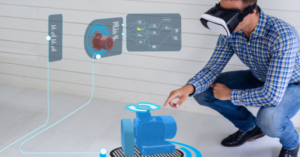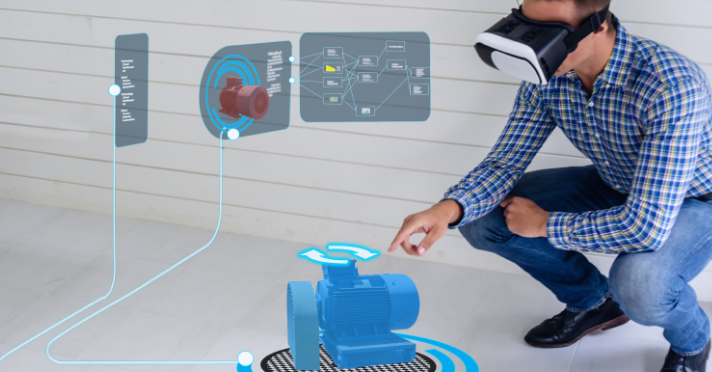The Role of Virtual Reality in Engineering Education and Training: Transforming Learning Experiences
Engineering education and training have traditionally relied on textbooks, lectures, and hands-on workshops to provide students with the necessary skills and knowledge. However, as technology advances, there is an increasing shift toward integrating digital tools that enhance learning and better prepare students for real-world challenges. One such technology is Virtual Reality (VR), which has gained significant attention for its potential to revolutionize engineering education. This article explores the role of VR in transforming the way engineers are trained and how it is shaping the future of engineering education.
What Is Virtual Reality (VR) and How Does It Work in Education?
Virtual Reality is an immersive technology that uses computer-generated environments to simulate real-world scenarios. Users interact with these environments through specialized hardware such as headsets, gloves, and motion sensors, allowing them to experience and manipulate virtual objects as if they were physically present. VR in education leverages these capabilities to create highly interactive and realistic learning experiences.
In the context of engineering education, VR provides students with the opportunity to engage in practical, hands-on experiences without the limitations of physical space, cost, or time. Whether it’s simulating complex machinery, building structures, or experimenting with engineering principles, VR offers an innovative way to bridge the gap between theoretical knowledge and practical application.
Benefits of Virtual Reality in Engineering Education
The integration of Virtual Reality into engineering education brings numerous advantages that enhance both the quality and accessibility of learning.
1. Hands-On Experience in a Safe Environment
One of the key benefits of VR is its ability to provide students with a realistic, hands-on experience without the associated risks. Engineering students often deal with complex equipment, machinery, or hazardous materials in their training, which can be costly or dangerous. VR enables students to interact with these systems in a virtual setting, allowing them to explore and practice their skills without risk to themselves or the equipment.
- Example: VR simulations can be used to teach students how to operate heavy machinery, repair complex systems, or troubleshoot electrical circuits safely, all without the need for physical materials or supervision.
2. Enhanced Visualization of Complex Concepts
Engineering concepts can be abstract and difficult to visualize, particularly when dealing with concepts like structural integrity, fluid dynamics, or thermodynamics. VR allows students to interact with these concepts in three-dimensional space, providing a deeper understanding of how systems work and behave under various conditions.
- Example: VR can simulate how a bridge would respond to different loads or how airflow interacts with an aircraft wing, enabling students to visualize and better understand engineering principles in action.
3. Real-World Simulations and Scenario-Based Learning
Virtual Reality enables scenario-based learning, where students can practice solving real-world problems in controlled, repeatable environments. For engineering students, this means they can encounter a wide variety of realistic situations, ranging from designing infrastructure to responding to equipment failures, all within the virtual world.
- Example: VR can simulate the design, construction, and testing of a building, allowing students to experience the full lifecycle of a project. Students can modify designs and test them under various conditions, learning valuable lessons along the way.
4. Cost-Effective Training Solutions
Traditionally, providing engineering students with access to expensive labs, equipment, or field sites for practical training can be a significant financial burden. VR reduces these costs by eliminating the need for physical materials and space. Instructors can use VR simulations to demonstrate complex systems or perform experiments that might otherwise require expensive setups.
- Example: Instead of purchasing costly equipment for lab experiments, universities can invest in VR tools that replicate these experiments virtually, allowing students to perform them as often as needed without the associated costs.
Applications of VR in Different Engineering Disciplines
The potential uses of Virtual Reality in engineering education are vast, with applications across various disciplines. Each field of engineering can benefit from VR technology to enhance practical learning and improve skill development.
1. Civil Engineering: Virtual Design and Construction
In civil engineering, VR can be used for the design and construction of infrastructure projects. Students can interact with 3D models of buildings, roads, and bridges, exploring how different materials and design choices impact structural integrity. VR also allows students to simulate the construction process, learning how to manage timelines, resources, and potential risks.
- Example: Civil engineering students can use VR to walk through a virtual construction site, examining structural elements and learning about the challenges involved in large-scale projects.
2. Mechanical Engineering: Prototyping and Testing
Mechanical engineering students can use VR to design and test prototypes in a virtual environment before creating physical models. This allows for rapid iteration and modification of designs, reducing the need for costly physical prototyping. VR also helps students visualize the inner workings of mechanical systems, making it easier to understand complex mechanisms.
- Example: A student can design a mechanical component in VR, test it for functionality and efficiency, and adjust the design in real-time without having to build a physical prototype.
3. Electrical Engineering: Circuit Design and Simulation
In electrical engineering, VR provides a unique way to simulate and visualize circuits and electrical systems. Students can design and test circuits in a virtual environment, experimenting with different components and configurations without the risk of damaging equipment.
- Example: VR can be used to simulate the operation of electrical systems, such as power grids or communication networks, allowing students to understand how electrical components interact in complex networks.
4. Aerospace Engineering: Flight Simulation and Aerodynamics
Aerospace engineering students can greatly benefit from VR in learning about flight dynamics, aerodynamics, and aircraft design. VR flight simulators provide an immersive way for students to practice piloting aircraft or test aerodynamics in virtual wind tunnels. They can experience the physics of flight firsthand and practice handling emergency scenarios or design optimizations.
- Example: Aerospace students can use VR to simulate different flight conditions, testing how aircraft perform under various weather conditions, altitudes, and speeds.
Challenges and Limitations of VR in Engineering Education
Despite its many benefits, the use of VR in engineering education is not without challenges. Some of the main concerns include:
- High Initial Costs: The hardware and software required for VR can be expensive, especially for institutions that need to outfit multiple classrooms or labs.
- Technical Limitations: Although VR technology is advancing, there are still limitations in terms of resolution, hardware performance, and realism. Some applications may not yet offer the level of detail required for highly specialized engineering disciplines.
- Limited Content Availability: While there is a growing library of VR simulations available, not all engineering fields have extensive VR content tailored to their specific needs.
The Future of VR in Engineering Education
The role of VR in engineering education is expected to grow significantly in the coming years. As technology improves and becomes more affordable, VR will become an even more integral part of engineering curricula. Future developments in VR, such as improved haptic feedback, better graphics, and more interactive simulations, will make the virtual learning experience even more immersive and effective.
Additionally, the integration of VR with other emerging technologies like Artificial Intelligence (AI) and Augmented Reality (AR) promises to further enhance the learning experience by creating dynamic, adaptive environments that respond to student input.
Conclusion: Enhancing Engineering Education for the Future
Virtual Reality is undeniably changing the landscape of engineering education and training. By providing students with immersive, hands-on experiences in a safe and cost-effective environment, VR is helping to bridge the gap between theoretical knowledge and real-world application. As VR technology continues to advance, it will play a key role in shaping the future of engineering education, making it more interactive, accessible, and effective in preparing the engineers of tomorrow.

Also Read :
